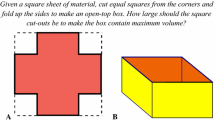Abstract
Recent investigations of mathematical problem solving have focused on an issue that concerns students' ability at accessing and making flexible use of previously learnt knowledge. I report here a study that takes up this issue by examining potential links between mental models constructed by students, the organisational quality of students' prior geometric knowledge, and the use of that knowledge during problem solving. Structural analysis of the results suggest that the quality of geometric knowledge that students develop could have a powerful effect on their mental models and subsequent use of that knowledge.
Similar content being viewed by others
REFERENCES
Alexander, P. and Judy, J.: 1988, ‘The interaction of domain-specific and strategic knowledge in academic performance’, Review of Educational Research 58, 375-404.
Australian Education Council: 1990, National Statement on Mathematics for Australian Schools,Carlton, Vic: Curriculum Corporation.
Board of Senior Secondary Studies: 1995, Examiner's Report (Mathematics 1), Brisbane.
Bereiter, C. and Scardamalia, M.: 1985, Cognitive coping strategies and the problem of ‘inert knowledge’. In S. S. Chipman, J. W. Segal and R. Glaser (eds), Learning skills Current research and open questions (Vol. 2, pp. 65-80). Hillsdale, N. J.: Lawrence Erlbaum.
Byers, V. and Erlwanger, S.: 1985, ‘Memory in mathematical understanding’, Educational Studies in Mathematics 16, 259-281.
Chi, M. T. H., Glaser, R. and Rees, E.: 1982, ‘Expertise in problem solving’. In R. J. Sternberg (ed.), Advances in the psychology of human intelligence (Vol. 1, pp. 7-76). Hillsdale, NJ: Lawrence Erlbaum.
Chiesi, H., Spilich, G. J. and Voss, J. F.: 1979, ‘Acquisition of domain-related information in relation to high and low domain knowledge’, Journal of Learning and Verbal Behaviour 18, 257-283.
De Jong, T. and Ferguson-Hessler, M. G. M.: 1986, ‘Cognitive structures of good and poor novice problem solvers in physics’, Journal of Educational Psychology 78, 279-288.
English, L. D.: 1997, Mathematical reasoning: Analogies, metaphors and images.Hillsdale, NJ: Lawrence Elrbaum.
English, L. D. and Halford, G. S.: 1995, Mathematics Education: Models and processes.Hillsdale, NJ: Lawrence Erlbaum.
Gentner, D.: 1983, ‘Structure mapping: A theoretical framework for analog’, Cognitive Science 7, 155-170.
Glaser, R.: 1984, ‘Education and thinking: The role of knowledge’, American Psychologist 39, 93-104.
Halford, G. S.: 1993, Children's understanding: The development of mental models. Hillsdale, NJ: Lawrence Erlbaum.
Johnson-Laird, P. N.: 1983, Mental models.Cambridge: Cambridge University Press.
Kintsch, W. and Greeno, J. G.: 1985, ‘Understanding and solving word arithmetic problems’, Psychological Review 92, 109-129.
Lawson, M. J. and Chinnappan, M.: 1994, ‘Generative activity during geometry problem solving: Comparison of the performance of high-achieving and low-achieving students’, Cognition and Instruction 12 (1), 61-93.
Lester, F. K.: 1988, ‘Reflections about mathematical problem-solving research’. In R. I. Charles and E. A. Silver (eds), The teaching and assessing of mathematical problem solving. Reston, Virginia: The National Council of Teachers of Mathematics.
Lester, F. K.: 1994, Musings about mathematical problem-solving research: 1970-1994. Journal for Research in Mathematics Education 25 (6), 660-675.
Mayer, R. E.: 1975, ‘Information processing variables in learning to solve problems’, Review of Educational Research 45, 525-541.
National Council of Teachers of Mathematics: 1989. Curriculum and Evaluation Standards for School Mathematics.Reston, Va.: The Council.
Nesher, P. and Hershkovitz, S.: 1994, ‘The role of schemes in two-step problems: Analysis and research findings’, Educational Studies in Mathematics 26, 1-23.
Prawat, R.: 1989, ‘Promoting access to knowledge, strategy and disposition in students’, Review of Educational Research 59, 1-42.
Resnick, L. B. and Ford, W. W.: 1981, The psychology of mathematics for instruction.Hillsdale, NJ: Lawrence Erlbaum.
Rouse, W. B. and Morris, N. M.: 1986, ‘On looking into the blackbox: Prospects and limits in the search for mental model’, Psychological Bulletin 100(3), 349-363.
Rumelhart, D. and Ortony, A.: 1977, ‘The representation of knowledge in memory’. In R. Anderson, R. Spiro and W. Montague (eds), Schooling and the acquistion of knowledge,Hillsdale, NJ: Erlbaum.
Schoenfeld, A. H.: 1985, Mathematical problem solving. New York: Academic Press.
Schoenfeld, A. H.: 1987, ‘On having and using geometric knowledge’. In J. Hiebert (ed.), Conceptual and procedural knowledge (pp 225-264). Hillsdale, NJ: Lawrence Erlbaum.
Sweller, J.: 1989, ‘Cognitive technology: Some procedures for facilitating learning, problem solving in mathematics and science’, Journal of Educational Psychology 81, 457-466.
Author information
Authors and Affiliations
Rights and permissions
About this article
Cite this article
Chinnappan, M. Schemas and mental models in geometry problem solving. Educational Studies in Mathematics 36, 201–217 (1998). https://doi.org/10.1023/A:1003134323371
Issue Date:
DOI: https://doi.org/10.1023/A:1003134323371




